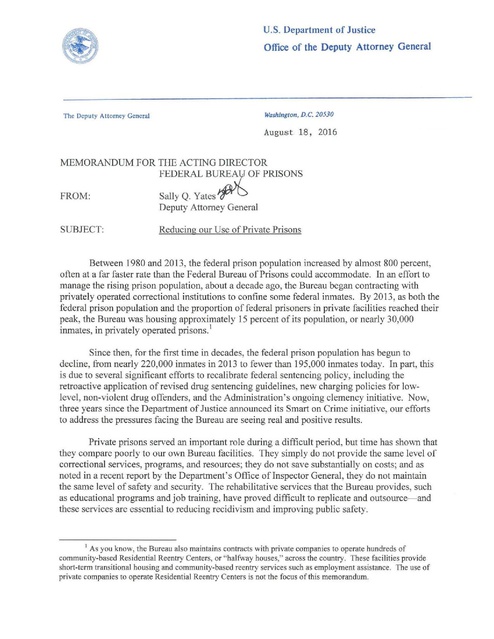News Articles
This site contains over 2,000 news articles, legal briefs and publications related to for-profit companies that provide correctional services. Most of the content under the "Articles" tab below is from our Prison Legal News site. PLN, a monthly print publication, has been reporting on criminal justice-related issues, including prison privatization, since 1990. If you are seeking pleadings or court rulings in lawsuits and other legal proceedings involving private prison companies, search under the "Legal Briefs" tab. For reports, audits and other publications related to the private prison industry, search using the "Publications" tab.
For any type of search, click on the magnifying glass icon to enter one or more keywords, and you can refine your search criteria using "More search options." Note that searches for "CCA" and "Corrections Corporation of America" will return different results.
Reducing our Use of Private Prisons, DOJ Yates memo, August 18, 2016

Document text
U.S. Department of Justice Office of the Deputy Attorney General Washington, D.C. 20530 The Deputy Attorney General August 18, 2016 MEMORANDUM FOR THE ACTING DIRECTOR FEDERAL BU~~y OF PRISONS FROM: SallyQ. Yates~ Deputy Attorney General SUBJECT: Reducing our Use of Private Prisons Between 1980 and 2013, the federal prison population increased by almost 800 percent, often at a far faster rate than the Federal Bureau of Prisons could accommodate. In an effort to manage the rising prison population, about a decade ago, the Bureau began contracting with privately operated correctional institutions to confine some federal inmates. By 2013, as both the federal prison population and the proportion offederal prisoners in private facilities reached their peak, the Bureau was housing approximately 15 percent of its population, or nearly 30,000 inmates, in privately operated prisons. 1 Since then, for the first time in decades, the federal prison population has begun to decline, from nearly 220,000 inmates in 2013 to fewer than 195,000 inmates today. In part, this is due to several significant efforts to recalibrate federal sentencing policy, including the retroactive application of revised drug sentencing guidelines, new charging policies for low level, non-violent drug offenders, and the Administration's ongoing clemency initiative. Now, three years since the Department of Justice announced its Smart on Crime initiative, our efforts to address the pressures facing the Bureau are seeing real and positive results. Private prisons served an important role during a difficult period, but time has shown that they compare poorly to our own Bureau facilities. They simply do not provide the same level of correctional services, programs, and resources; they do not save substantially on costs; and as noted in a recent report by the Department' s Office oflnspector General, they do not maintain the same level of safety and security. The rehabilitative services that the Bureau provides, such as educational programs and job training, have proved difficult to replicate and outsource- and these services are essential to reducing recidivism and improving public safety. 1 As you know, the Bureau also maintains contracts with private companies to operate hundreds of community-based Residential Reentry Centers, or "halfway houses," across the country. These facilities provide short-term transitional housing and community-based reentry services such as employment assistance. The use of private companies to operate Residential Reentry Centers is not the focus of this memorandum . For all these reasons, lam eager to enlist your help in beginning the process of reducing--and ultimately ending-our use of privately operated prisons. As you know, all of the Bureau's existing contracts with private prison companies are term-limited and subject to renewal or termination. I am directing that, as each contract reaches the end of its term, the Bureau should either decline to renew that contract or substantially reduce its scope in a manner consistent with law and the overall decline of the Bureau's inmate population. I am aware that the Bureau is already taking steps in this direction. Three weeks ago, the Bureau declined to renew a contract for approximately 1,200 beds. Today, concurrent with the release of this memo, the Bureau is amending an existing contract solicitation to reduce an upcoming contract award from a maximum of 10,800 beds to a maximum of 3,600. Taken together, these actions will allow the Bureau to end the housing of inmates at three or more private contract facilities over the next year, and will reduce the total private prison population to less than 14,200 inmates by May 1, 2017-a greater than 50 percent decrease since 20 I 3. These steps would be neither possible nor desirable without the Bureau's superb and consistent work at our own facilities. I am grateful for the tremendous and often unheralded work done by Bureau staff. When a higher proportion of America's prison population benefits from those efforts, we will improve outcomes for them, for law enforcement, and for the wider community we serve. As a career prosecutor and fellow law enforcement professional, I thank you and your staff for your extraordinary service to this nation. CC: Lee Lofthus, Assistant Attorney General for Administration 2

